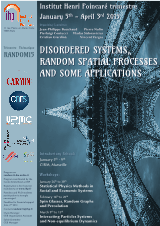The spectacular success of probability theory within the hard sciences
is well known since its pivotal role in the statistical mechanics
approach to thermodynamics. It is interesting to notice, nevertheless,
that when probability was first included into a higher mathematics
curriculum, it was with the purpose to approach socio-economic
problems:
“Enfin, on donnera les principes de la théorie des probabilités. Dans
un temps où tous les citoyens sont appelés à décider du sort de leurs
semblables, il leur importe de connaître une science qui fait
apprécier, aussi exactement qu’il est possible, la probabilité des
témoignages, et celle qui résulte des circonstances dont les faits
sont accompagnés : il importe surtout de leur apprendre à se défier
des aperçus même les plus vraisemblables ; et rien n’est plus propre à
cet objet que la théorie des probabilités, dont souvent les résultats
rigoureux sont contraires à ces aperçus. D’ailleurs, les nombreuses
applications de cette théorie, aux naissances, aux mortalités, aux
élections et aux assurances, applications qu’il est avantageux de
perfectionner et d’étendre à d’autres objets, la rendent une des
parties les plus utiles des connaissances humaines”
from Lagrange and Laplace opening lecture at Ecole Normale, January 20th 1795
In the past however, the application of
probabilistic methods to problems of this type, has never gone beyond
minor achievements, apart perhaps from a few exceptions. Recently
though, the availability of large databases and the advent of computer
facilities has created a fertile ground for probabilistic methods to
grow, especially when they originate from statistical mechanics. At
the same time the progresses made in the last decades in the studies
of non-homogenous disordered systems have produced new promising
approaches and technical tools for applied research topics.
The trimester aims at bringing together scientists working on the
following three topical areas, with strong common cultural roots and
wide research interest intersections:
- probabilistic methods on random spatial processes, for instance on growth models, percolation, coalescence, non-equilibrium phase transitions.
- statistical mechanics of interacting particle systems, especially disordered models like spin glasses, diluted systems, directed and pinned polymers.
- “complex systems” approached with mathematical and physical methods, in particular agent based models applied to socio-economic problems, inverse problems, multi-fractal models.
The program, anchored around those three main topics and subtopics,
will be built on a school, three one-week workshops, various
mini-symposia, research group meetings and three open lectures for a
wide public audience.

